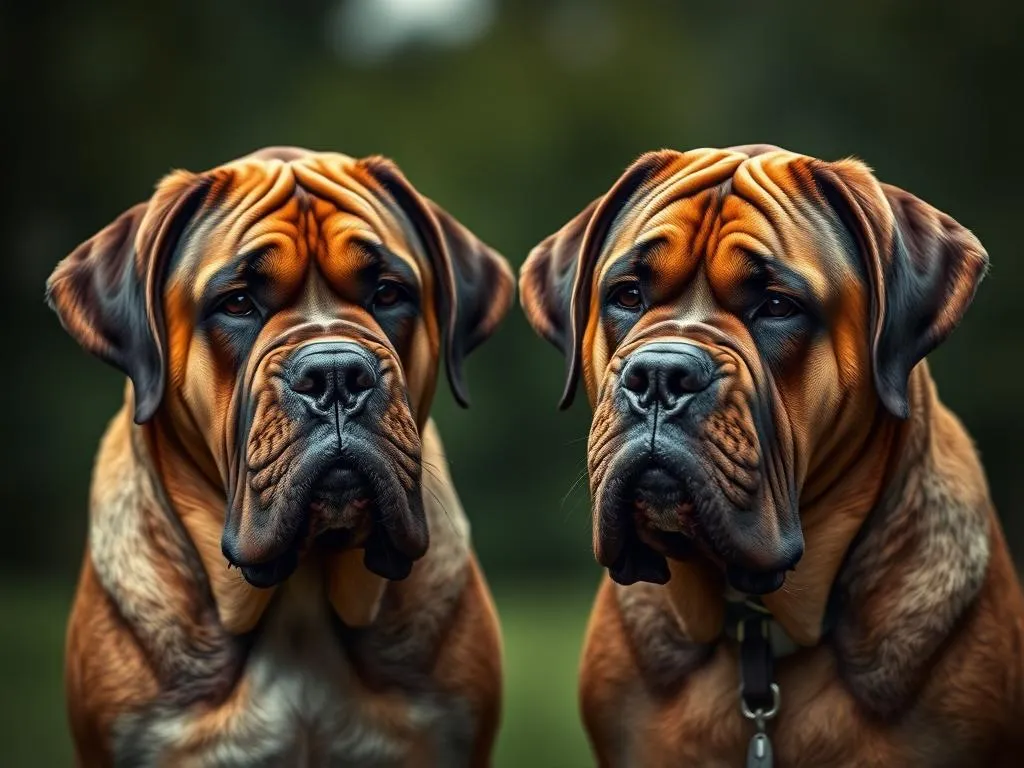
Mastiffs are a majestic breed, known for their formidable size and gentle temperament. As one of the oldest dog breeds, they have a rich history that makes them unique companions. Understanding the male vs female Mastiffs differences is crucial for potential owners. Each gender has distinct characteristics, behaviors, and needs that can influence the choice of a family pet. This article explores these differences to help you make an informed decision.
Understanding the Mastiff Breed
History of Mastiffs
Mastiffs trace their lineage back thousands of years, with some of their ancestors believed to have originated in ancient Mesopotamia. They played various roles throughout history, including guarding homes, hunting big game, and serving as war dogs. The Romans admired Mastiffs for their strength and courage, using them in battles and gladiatorial events. Over time, Mastiffs have been cherished as loyal companions and devoted family members across cultures.
Characteristics of Mastiffs
Mastiffs are characterized by their impressive size, with males typically weighing between 160 to 230 pounds and females ranging from 120 to 170 pounds. Their coat is short and can come in various colors, including fawn, brindle, and apricot. Beyond their physical traits, the breed is renowned for its gentle and protective nature. Mastiffs are known to be affectionate with their families and often act as natural guardians.
Male vs Female Mastiffs: Key Differences
Physical Differences
When it comes to male vs female Mastiffs, physical differences are notable. Males tend to be larger and heavier than females, with broader heads and chests. While both genders have similar coat types, males may have coarser fur. Grooming needs are generally the same, but males might require more frequent brushing during shedding seasons due to their larger size.
Temperament Differences
Temperament can also vary between male and female Mastiffs. Males are often more assertive and protective, which can be beneficial for guarding but may require more socialization to prevent aggressive behavior. Females, on the other hand, are usually more nurturing and affectionate, often forming stronger bonds with their owners. This difference can influence how each gender behaves in various social settings.
Health Considerations
Health issues can differ between male and female Mastiffs. Males may be prone to certain conditions like hip dysplasia and heart problems due to their size and weight. Female Mastiffs can experience health issues related to reproductive functions, such as pyometra and certain cancers. Regular veterinary check-ups are vital for both genders to ensure they maintain good health.
Personality Traits of Male and Female Mastiffs
Male Mastiffs
Male Mastiffs are often described as confident and protective. They tend to be more independent, which can sometimes lead to stubbornness in training. In social settings, they may display dominance over other dogs, making early socialization crucial. However, their loyalty and commitment to their families make them wonderful companions.
Female Mastiffs
Female Mastiffs are generally more intuitive and responsive to their owner’s emotions. They often seek companionship and may become more attached to their families than males. In social situations, females may be more welcoming towards other animals but can also exhibit strong maternal instincts, especially if they have had puppies. Their gentle nature makes them great with children and other pets.
Training and Socialization
Training Male Mastiffs
Training male Mastiffs requires patience and consistency. They respond well to positive reinforcement methods, such as treats and praise. However, their strong-willed nature can lead to challenges, especially if they sense a lack of authority. Establishing yourself as the leader is crucial. Early socialization with other dogs and people is vital to reduce potential aggression.
Training Female Mastiffs
Female Mastiffs are often easier to train compared to males, thanks to their desire to please their owners. They typically respond well to commands and are more willing to cooperate in training sessions. However, they can also be sensitive to reprimands, so a gentle approach is essential. Socialization is equally important for females to ensure they are well-adjusted and friendly.
Lifestyle and Care Considerations
Exercise Needs
Both male and female Mastiffs require regular exercise, but their needs may differ slightly. Males often have higher energy levels and may require more vigorous activities, such as long walks or play sessions. Females may be more content with moderate exercise, such as leisurely walks. However, both genders benefit from daily physical activity to maintain a healthy weight and prevent boredom.
Nutrition Requirements
Dietary considerations for male Mastiffs should focus on maintaining their weight and supporting their joint health, given their larger size. High-quality, specially formulated large breed dog food is recommended. Female Mastiffs, particularly during heat cycles or pregnancy, may have different nutritional needs, requiring adjustments in their diet to ensure proper health and energy levels.
Grooming and Maintenance
While both male and female Mastiffs have similar grooming needs, males may shed more due to their size. Regular brushing is essential to manage shedding and keep their coat healthy. Bathing should be done as needed, but over-bathing can strip their coat of natural oils. Both genders benefit from routine dental care and nail trimming.
Choosing the Right Mastiff for You
Factors to Consider
When deciding between a male or female Mastiff, consider your lifestyle and living situation. Males might be more suitable for active families who can provide the necessary training and socialization. In contrast, females may be better for those seeking a more nurturing and affectionate companion. Additionally, consider family dynamics, such as children and other pets, to determine which gender would fit best.
Recommendations for Potential Owners
For potential owners, male Mastiffs thrive in environments where they can participate in various activities and receive consistent training. They are ideal for families who can provide firm leadership and socialization. Female Mastiffs, conversely, are well-suited for families looking for a loyal and affectionate companion. They excel in homes where they can receive plenty of love and attention.
Conclusion
In summary, understanding the differences between male vs female Mastiffs is essential for potential owners. Males tend to be larger and more assertive, while females are often more nurturing and intuitive. Each gender has its unique characteristics and needs, making it crucial to align your choice with your lifestyle and preferences. Whether you choose a male or female Mastiff, both can provide unwavering loyalty and companionship.
FAQs
Are male Mastiffs more aggressive than females?
While male Mastiffs can exhibit more assertive behavior, aggression is not determined solely by gender. Proper training and socialization play a significant role in a dog’s temperament.
What is the average lifespan of a Mastiff?
The average lifespan of a Mastiff ranges from 6 to 12 years, with proper care and nutrition contributing to a longer, healthier life.
Do Mastiffs require a lot of space?
Mastiffs do not necessarily require vast amounts of space, but they benefit from a home with a secure yard where they can exercise and play. Regular walks are essential for their health.
How do male and female Mastiffs get along with other pets?
Both male and female Mastiffs can coexist with other pets if socialized properly. Early introduction and supervision are key to ensuring harmonious relationships.









